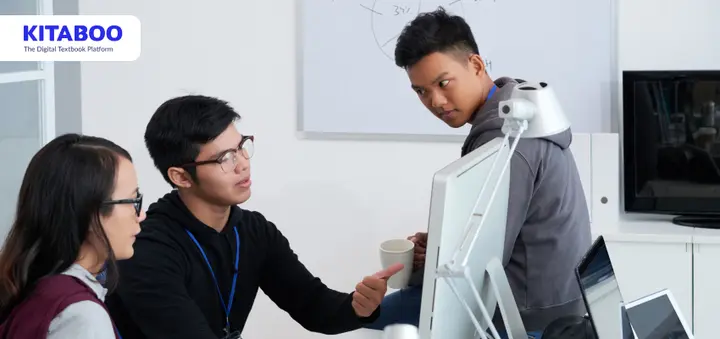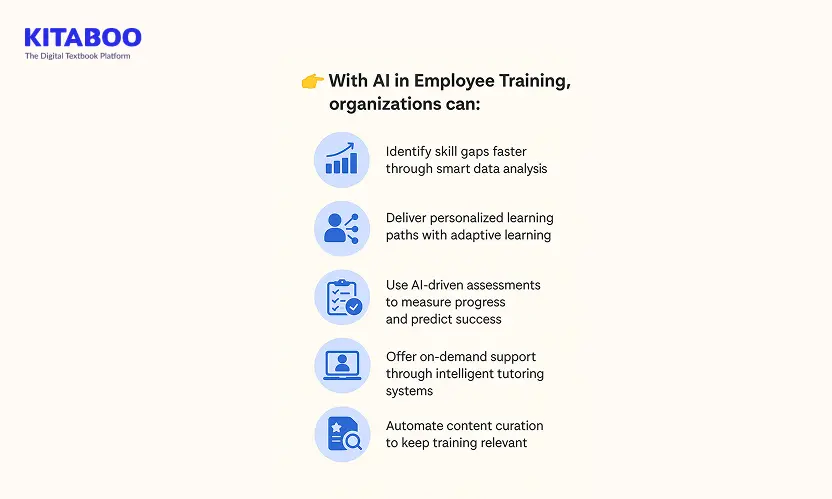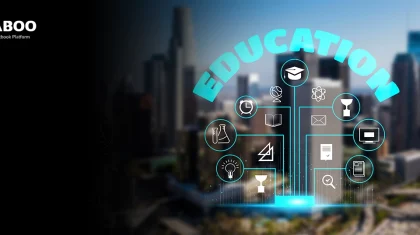
Why and How To Use AI in Employee Training and Development
Summarize this blog with your favorite AI:
Why and How To Use AI in Employee Training and Development - TL;DR
Employee training is no longer just a to-do activity. Businesses have realized its role in business growth and employee success. L&D leaders are expected to do a lot more than simply deliver static learning content.
More emphasis is given on personalizing learning pathways that adapt to individual skills, style, and preferences. Interactive content and assessments are needed to enhance the overall learning experience.
You must identify the current skill gaps and close them. You must deliver training content that promises engagement and retention. Moreover, you must create a continuous learning culture where upskilling is the priority.
L&D leaders can’t achieve this by relying on traditional training methods. They need to leverage the power of AI in employee training and redefine how training is approached.
Here’s how you can use AI to transform training:
- Build adaptive learning paths to suit individual learning styles and skill levels.
- Use AI-driven assessments to track progress and identify problem areas early.
- Automate content curation with AI to deliver just-in-time training based on learner behavior and goals.
- Enable 24/7 support using intelligent tutoring systems for on-demand help.
- Leverage rich data and offline sync to use AI-powered insights for better data-driven decision-making.
Platforms like KITABOO combine all these capabilities into one AI-powered, mobile-first solution. KITABOO makes it easier for training companies to deliver engaging, intelligent, and effective employee learning experiences.
“The training completion rates are good, but my team still lacks critical skills.”
“I’ve invested a lot in training programs, but are they adapting to my employees’ learning needs?”
“Employees aren’t getting adequate and on-demand learning support. What can I do?”
If these questions trouble you regularly, your training strategy needs a complete overhaul. Mind you, the underwhelming outcome is not because of any lack of effort. It’s because you are still relying on traditional training when the world has embraced AI.
You might have multiple challenges, but AI in employee training has the answer to them all. If you are still debating why you must use AI in training, we’re about to clear your doubts.
Table of Contents
I. What’s Driving the Shift to AI in Employee Training and Development?
II. How to Use AI in Employee Training and Development
- Build adaptive learning paths to match each employee’s needs
- Use AI-driven assessments to go beyond completion rates
- Automate content curation with AI-powered tutoring logic
- Use intelligent tutoring systems to support real-time guidance
- Make AI smarter with the right data and offline support
III. Conclusion
IV. FAQs
What’s Driving the Shift to AI in Employee Training?
Traditionally, training has been looked at as an overhead cost. It was simply about checking the box and delivering information. Engagement, assessments, and skill application were never given any importance.
However, as the market competition and client expectations evolved, businesses realized the importance of building a highly skilled workforce. Training has become a growth factor.
L&D leaders invest a huge chunk of their budgets in employee training programs. They are under pressure to scale training across roles, regions, and departments. They are expected to track learning progress to measure ROI.
Moreover, they have to ensure the training programs adapt to individual learning styles. They must identify and address the skill gaps. And they have to deliver a very intuitive, adaptive, personalized learning experience to every learner.
Doing this manually is next to impossible and highly error-prone. This is why AI in employee training has become a blessing for L&D leaders. With smart use of AI, they can automate these tasks and ensure accuracy, reliability, and efficiency.
The WHY behind using AI in employee training is simple – to ensure engagement, retention, upskilling, and performance. Training companies and L&D leaders can do this without burning their resources.
How to Use AI in Employee Training and Development?
While AI is extremely powerful, it will not yield any results if you lack a proper strategy. If you haven’t figured out the areas in employee training where AI can drive growth, here’s what you can do:
1. Build adaptive learning paths to match each employee’s needs
Traditional training treats everyone the same. But employees come with different skills, speeds, and learning styles. If the training is too easy, they disengage. Too hard, and they give up.
This is where adaptive learning matters. It customizes the experience in real time, changing content, pace, or format based on how the learner performs.
This kind of flexibility is only possible with AI. It understands learner behavior, predicts needs, and adjusts accordingly.
Platforms like K make adaptive learning possible at scale. KITABOO’s AI-powered learning capabilities analyze how employees interact with content. It builds adaptive and personalized paths based on their skill levels and performance.
2. Use AI-driven assessments to go beyond completion rates
Most traditional assessments offer a simple snapshot of pass or fail. But to truly improve skills, you need to understand why someone is struggling.
AI-driven assessments track patterns across multiple sessions, measure cognitive effort, and highlight conceptual gaps. They go beyond surface metrics to uncover deeper learning needs.
This is where AI in employee training gets strategic. K-AI, KITABOO’s AI-powered learning assistant, uses AI-driven assessments to help L&D teams improve learning outcomes.
3. Automate content curation with AI
Manual content creation is slow and often disconnected from what learners really need. AI-powered content curation changes this narrative. It recommends or assembles content based on role, skill level, learning goals, and past behavior.
KITABOO brings this to life by analyzing what employees are learning, how they’re performing, and what’s next. It automates content curation based on learner behavior and training goals.
Moreover, it suggests the right modules at the right time. This kind of dynamic, needs-based content delivery is the backbone of effective learning.
How to Guide:
Transform Your Employee Training with AI in 2024
and Beyond
4. Use intelligent tutoring systems to support real-time guidance
One of the biggest frustrations in digital learning is being stuck with no help. Intelligent tutoring systems solve that. These AI tools act like 24/7 available mentors, guiding learners through tough concepts, answering questions, and offering instant feedback.
This kind of learning support is essential. It keeps momentum going and builds learner confidence. KITABOO’s AI-powered learning assistant, K-AI, includes intelligent tutoring systems that create self-assessments to help employees learn better.
5. Make AI smarter with the right data and offline support
For AI in employee training to work well, it needs high-quality, consistent data. Every click, pause, and replay helps the system understand what’s working and what’s not.
And in many industries, learners need offline access. This demands that the AI must sync insights even when the internet is limited.
KITABOO solves both problems. Its real-time analytics and offline sync features enhance AI-based data inputs. The AI layer collects rich learning data across devices, even in an offline environment.
This fuels better adaptive learning, more accurate AI-driven assessments, and smarter recommendations from intelligent tutoring systems.
Conclusion
Every great strategy needs the right tool for execution. Your strategies for AI in employee training will benefit from an AI-powered tool like KITABOO.
KITABOO offers multiple AI capabilities that help you improve the learning experience, delivery and engagement. Right from automated content curation to performance-based learning pathways, KITABOO helps you enhance learning outcomes.
If you want to help your learners upskill faster, KITABOO is the AI-powered platform you need to lead the future of workforce development.
Schedule an exclusive demo to start your journey towards AI-powered training.
FAQs
AI redefines how training programs are planned and delivered. It brings hyper-personalization to ensure training adapts to learners and not the other way around. It helps you track progress, assess skills, and improve engagement without any manual efforts.
AI can help you enhance soft skills. AI-powered training programs can simulate real-life scenarios and assess your soft skills. It will provide instant feedback and help you improve your soft skills that align with your role and KPIs.
Yes. AI-powered learning assistants like K-AI by KITABOO provide on-demand instant support and guidance to learners. They don’t have to wait for admin support or go through manuals to find answers.
Adaptive learning is when the training programs adapt to the learner’s skill levels, role, experience, and goals. If a learner prefers video content, AI-powered adaptive learning paths will push more training videos.
Discover how a mobile-first training platform can help your organization.
KITABOO is a cloud-based platform to create, deliver & track mobile-first interactive training content.




